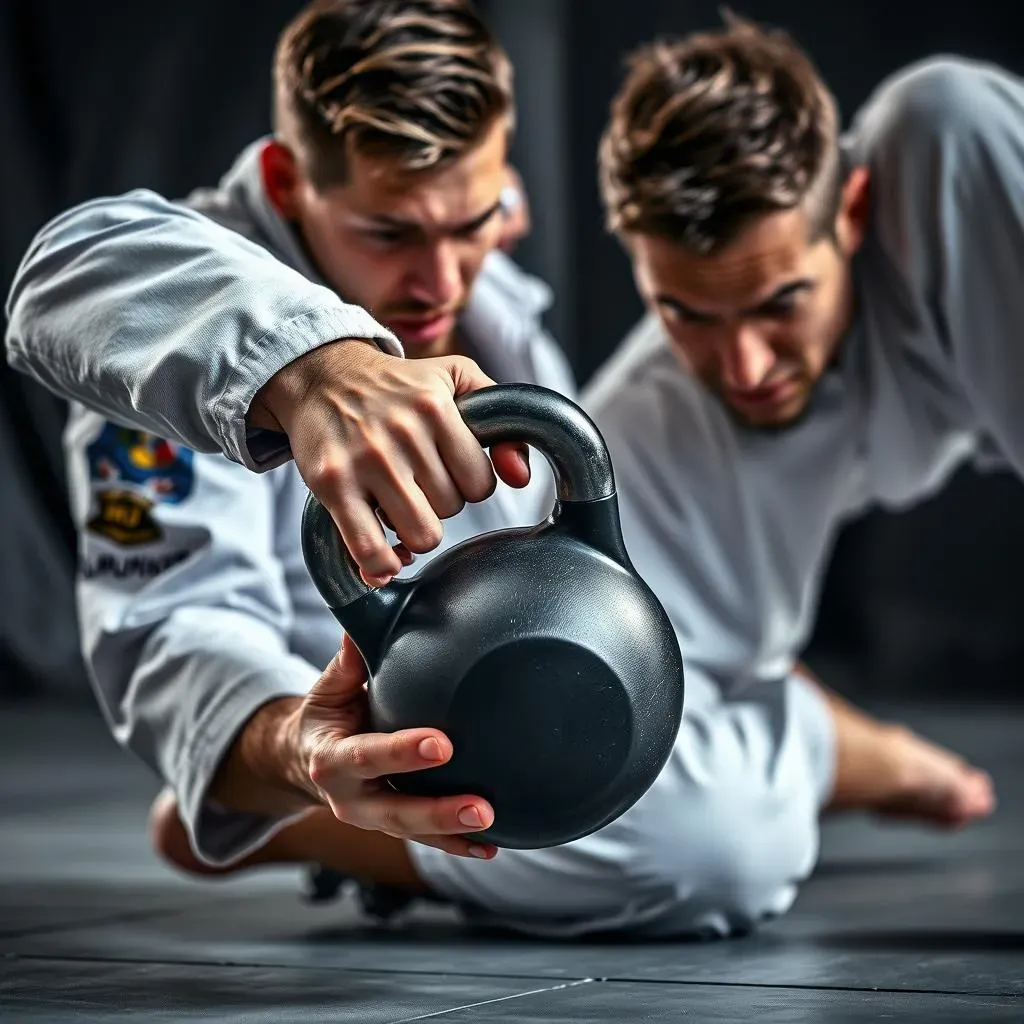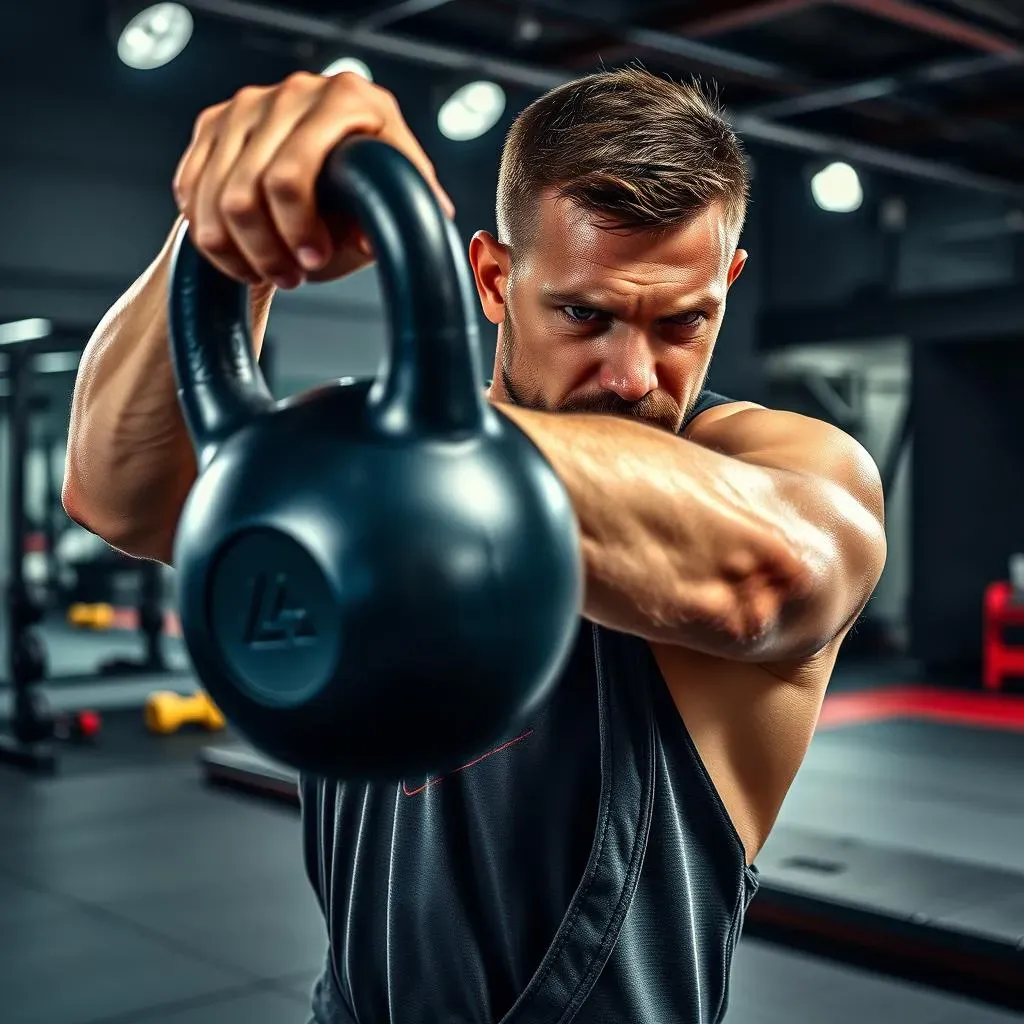Table of Contents
Want to dominate on the mats? Brazilian Jiu Jitsu (BJJ) demands more than just technique; it requires raw strength, explosive power, and relentless endurance. That's where the kettlebell comes in. A well-structured kettlebell workout for jiu jitsu can be a total game-changer, boosting your performance in ways you never thought possible.
Why Kettlebells Are a GameChanger for Jiu Jitsu

Why Kettlebells Are a GameChanger for Jiu Jitsu
So, why kettlebells? It's simple: they build functional strength. BJJ isn't about isolating muscles; it's about using your entire body as a connected unit. Kettlebell exercises mimic the movements you make on the mat – think hip drive for sweeps, core stability for guard retention, and grip strength for submissions. Dumbbells and barbells are great, but kettlebells force you to control an offset load, which engages your stabilizer muscles and improves your overall body awareness. It's like adding a cheat code to your grappling game.
Benefit | How it Helps BJJ |
|---|---|
Improved Grip Strength | Essential for controlling your opponent and securing submissions. |
Enhanced Core Stability | Provides a solid base for generating power and resisting attacks. |
Increased Explosive Power | Allows for faster takedowns, sweeps, and escapes. |
Better Conditioning | Kettlebell circuits build the stamina needed for long rolls. |
Essential Kettlebell Exercises for BJJ Performance

Essential Kettlebell Exercises for BJJ Performance
Alright, let's get down to the nitty-gritty: which kettlebell exercises are going to give you the most bang for your buck on the mat? Forget the fancy stuff you see on Instagram. We're focusing on movements that directly translate to improved grappling performance. These aren't just random exercises; they're the bread and butter of a solid kettlebell workout for jiu jitsu.
First up, we've got kettlebell swings. These are king for building explosive hip power, which is crucial for takedowns, sweeps, and generating force from the bottom position. Then there are Turkish get-ups. They might look weird, but they're a full-body mobility and stability test that will bulletproof your core and improve your movement patterns. Don't forget goblet squats, which build leg strength and improve your posture, essential for maintaining a strong base. And finally, kettlebell snatches, which combine power, coordination, and conditioning into one brutal exercise. These are the foundational movements that will take your BJJ to the next level.
Crafting Your Kettlebell Workout Plan for Jiu Jitsu

Crafting Your Kettlebell Workout Plan for Jiu Jitsu
Start Simple, Aim High
Building a kettlebell workout for jiu jitsu isn't about throwing a bunch of exercises together and hoping for the best. It's about creating a structured plan that progressively challenges you while complementing your BJJ training. If you're new to kettlebells, start with the basics: swings, goblet squats, and Turkish get-ups. Master these movements before moving on to more complex exercises like snatches or cleans. Remember, quality over quantity. Focus on proper form to avoid injuries and maximize the benefits.
Think of your kettlebell training as an accessory to your BJJ, not the main event. You don't want to be so sore from lifting that you can't perform well on the mats. Start with two to three sessions per week, lasting no more than 30-45 minutes. Listen to your body and adjust the intensity and volume as needed. It's a marathon, not a sprint.
Sample Weekly Schedule
Here's a sample weekly schedule to give you an idea of how to structure your kettlebell workout for jiu jitsu:
- Monday: BJJ Training
- Tuesday: Kettlebell Workout (Swings, Goblet Squats, Get-Ups)
- Wednesday: Active Recovery (Light stretching, foam rolling)
- Thursday: BJJ Training
- Friday: Kettlebell Workout (Snatches, Rows, Lunges)
- Saturday: Open Mat/Sparring
- Sunday: Rest
Progressive Overload and Variation
To keep making progress, you need to progressively overload your body. This means gradually increasing the weight, reps, or sets over time. For example, if you're currently doing 3 sets of 10 swings with a 24kg kettlebell, aim to increase to 3 sets of 12 reps, or increase the weight to a 28kg kettlebell while maintaining the same reps. Small, consistent increases will lead to significant gains over time.
Don't be afraid to experiment with different variations of the exercises. For example, you can try single-arm swings, alternating swings, or deficit goblet squats to challenge your body in new ways. Just make sure you maintain proper form and don't sacrifice quality for complexity. Variety is the spice of life, and it will also help prevent plateaus and keep your training engaging.
Avoiding Pitfalls and Maximizing Gains in Your Kettlebell Jiu Jitsu Journey

Avoiding Pitfalls and Maximizing Gains in Your Kettlebell Jiu Jitsu Journey
Alright, so you're swinging kettlebells and feeling like a grappling machine. Awesome! But before you get too carried away, let's talk about avoiding common mistakes and maximizing your gains. This isn't just about lifting heavy things; it's about smart training that complements your BJJ and keeps you healthy. Overtraining is a real issue, and it's easy to fall into the trap of doing too much, too soon. Remember, your body needs time to recover and adapt. Listen to it! If you're constantly sore or fatigued, you're probably pushing too hard. Scale back the intensity or volume and prioritize recovery.
Another common mistake is neglecting proper form. I know, I sound like a broken record, but it's crucial. Bad form not only reduces the effectiveness of the exercises but also increases your risk of injury. Find a qualified kettlebell instructor who can teach you the proper technique and provide feedback. It's an investment that will pay off in the long run. And finally, don't forget about active recovery. Light stretching, foam rolling, and mobility work can help reduce muscle soreness, improve flexibility, and prevent injuries. Think of it as preventative maintenance for your body.
Pitfall | Solution |
|---|---|
Overtraining | Prioritize recovery, listen to your body, and adjust intensity. |
Poor Form | Seek qualified instruction and focus on quality over quantity. |
Neglecting Recovery | Incorporate active recovery techniques like stretching and foam rolling. |
To truly maximize your gains, you need to be consistent with your training and track your progress. Keep a training log to monitor your sets, reps, and weight. This will help you identify areas where you're improving and areas where you need to focus more attention. Also, don't be afraid to experiment with different exercises and workout structures to find what works best for you. Everyone's body is different, so what works for one person might not work for another. The key is to stay curious, keep learning, and never stop pushing yourself to improve. With the right approach, a kettlebell workout for jiu jitsu can be a powerful tool for unlocking your full potential on the mats.
Wrapping Up Your Kettlebell Jiu Jitsu Journey
Integrating a kettlebell workout for jiu jitsu isn't just about lifting weights; it's about building a stronger, more resilient you. By focusing on compound movements, proper form, and consistent progression, you'll see improvements in your strength, endurance, and overall grappling performance. Remember to listen to your body, prioritize recovery, and adjust your program as needed. Now go out there, swing those kettlebells, and dominate the mats!